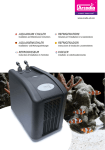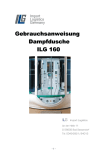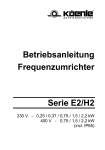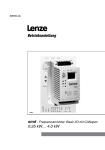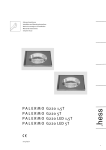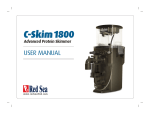Download • Installation and Maintenance Instructions
Transcript
• Installation and Maintenance Instructions • Instructions d’installation et d’entretien • Installations- und Wartungsanleitungen 2 1 >50cm >20cm 4 3 5 Installation Instructions READ AND FOLLOW ALL INSTALLATION INSTRUCTIONS DANGER - To avoid possible electric shock, special care should be taken since water is employed in the use of aquarium equipment. For each of the following situations, do not attempt repairs by yourself; return the appliance to an authorised service facility for service facility for service or discard the appliance: SAVE THESE INSTRUCTIONS! This product is designed for indoor use and the illumination of aquariums and terrariums only and will provide a good and safe service life provided that these instructions are followed. Failure to do so may result in serious personal injury or property damage. If you are in any doubt about the installation or operation of this product, please consult a qualified and experienced electrician. Check that the voltage and frequency rating on the product label is the same as your electrical supply before proceeding further. WARNING - To guard against injury, basic safety precautions should be observed, including the following: Maintenance 1. Caution! Disconnect all appliances in the aquarium from the mains supply before putting your hands in the water or maintaining the pendant. 2. Always support the pendant when adjusting its height and physically prevent it from falling onto the aquarium or into the water. 3. Do not operate pendant less than 20cm above the maximum possible water level in the aquarium. 4. Do not operate pendant closer than 50cm to the ceiling. 5. Do not operate pendant in an enclosed or hooded aquarium. 6. Regularly check the security of all parts of your hanging mechanism. See illustration 1. 7. The luminaire can get very HOT. Never touch the pendant while it is operating and allow adequate time for it to cool before attempting any maintenance. 8. Harmful UV output! Never operate the pendant without the protective shield. Replace any cracked protective shield. 9. Do not operate the pendant with defective or ‘end of life’ lamps - Circuit damage may occur. Replace lamps promptly with a lamp of the correct type and correct wattage. It is advisable to keep spare lamps in readiness. Physical Installation Select a suitable site close to your electricity supply. You should take into consideration the electrical supply rating of your outlet and wall and the strength of your ceiling or wall structure. Do not connect you luminaire to a power supply during installation. The Luminaire is suitable for indoor use only, and must only be placed above an Aquarium not less than 20cm above the maximum possible water level. See illustration 2. This luminaire does not have special protection against the ingress of water and should always be kept dry, ventilated and away from other heat sources. It is preferable to install your pendant with a clear and unobstructed space below. However, if installing over an existing aquarium, take adequate precautions to protect it from drilling dust, tools, or any other falling objects. Make sure that the light from the luminaire is aimed solely at the water within the aquarium. Do not allow the light to spill out, as looking directly into some lamps for more than a few minutes could be harmful to the human eye. The pendants are heavy so ensure that your fastenings, and the wall or ceiling position you are fixing them to, are suitable. Where ceilings are not suitable because of their height or construction, the Arcadia ‘Wall Mount’ bracket allows pendants to be mounted on the wall. Wire Suspension Kit: Comprises of the following parts: A. Ceiling attachment. B. Screw cap. C. Suspension wire with bead. D. Quick-adjust holder. 2 Installation and Maintenance Instructions Fixing centres for this method can vary, but we would advise a distance between fixing centres of approx 2/3 of the Pendant length. The bracket supporting the Quick-adjust holder can be moved and locked into the correct position easily. The following MINIMUM screw sizes should be used, when fixing the suspension system: • M5 Machine screws. M5 screws will fix directly into the suspension ceiling barrel. • 50mm long x 4mm (shaft) wood screw. Securely fix the ceiling attachments to your ceiling using the most suitable method of fastening, either screws or nuts and bolts. Pass the suspension wire through the screw cap, so that the bead sits inside. Tightly screw the screw cap into the ceiling attachment. It is advisable to tighten it with a spanner to ensure that it will not come undone accidentally. You will need to hold the ceiling attachment in a pair of pliers with a soft cloth to avoid scratching it. When both suspension wires are in place, feed the wires down through the buttons on top of the Quick-adjust holders which will automatically hold the wires in position. To lower the height of the pendant, support the pendant one end at a time, and release the wire by depressing the button at the top of the Quick-adjust. To raise the pendant, support it and pull the wire through the hole in the side of the Quick-adjust holders. When adjusting the pendant always ensure that there is sufficient wire to achieve your target height. Always leave a minimum 10 mm of wire showing. Excess wire can often be concealed in the channel on the top. If cutting the wire, wrap the wire with masking tape and cut with sharp, heavy duty side cutters. Electrical Installation This appliance must be earthed and the circuit must be protected by a suitable fuse! This unit must be protected by a suitable fuse. Before installing, ensure that the rated voltage and frequency of the luminaire match that of your supply, and that the mains lead plug is fully compatible with your mains socket. If in doubt, please return the unit to the point of purchase to verify. 3 Important!: Fusing. When discharge lamps are switched on, the current drawn from the supply can be analysed as: Inrush current - for a few milliseconds Starting current - for a few minutes Running current - after the lamp has stabilised. The fuse that protects the circuit must withstand all of the above currents with the inrush current normally being the most onerous (up to 25 x starting current). Ensure that a correctly rated fuse is used. Nuisance tripping is possible on some types of modern current limiting devices, and they may not be suitable. Consult your fuse or circuit breaker manufacturer for advice. Increasing fuse ratings will also mean that the supply cable size may need to be reviewed to support the higher fuse rating. The current ratings above will also apply to any timer switch apparatus connected to the circuit(s) or other switching apparatus controlling the circuit(s). Ensure your domestic wiring supply is rated appropriately. EARTHING (GROUNDING) INSTRUCTIONS This appliance should be earthed to minimise the possibility of electric shock. This appliance is equipped with an electric cord having an equipment earth wire conductor and a grounding type plug. The plug must be plugged into an outlet that is installed and earthed in accordance with all appropriate codes and ordinances. Safety and Maintenance Instructions IMPORTANT! the cord and coming in contact with the socket. See illustration 3 ALWAYS COMPLY WITH THESE INSTRUCTIONS Close supervision is necessary when any appliance is used by or near children. WARNING - To guard against injury, basic safety precautions should be observed, including the following: To avoid injury, do not contact moving parts or hot parts such as heaters, reflectors, lamp bulbs, and the like. READ AND FOLLOW ALL SAFETY INSTRUCTIONS. Always unplug an appliance from an outlet when not in use, before putting on or taking off parts, and before cleaning. Never pull on the cord to remove the plug from the socket. Instead, grasp the plug and pull to disconnect. DANGER - To avoid possible electric shock, special care should be taken since water is employed in the use of aquarium equipment. For each of the following situations, do not attempt repairs by yourself; return the appliance to an authorised service facility for service facility for service or discard the appliance: Do not use this luminaire other than for the intended use. The use of non- Arcadia attachments or accessories is not recommended, and may cause an unsafe condition. 1. If the appliance falls into the water, DON’T reach for it! First unplug it and then retrieve it. If electrical components of the appliance get wet, unplug the appliance immediately. Make sure the luminaire is mounted securely over the tank before operating it. 2. If the appliance shows any sign of abnormal water leakage, immediately unplug it from the power source. 3. Carefully examine the appliance after installation. It should not be plugged in if there is water on parts not intended to get wet. 4. Do not operate any appliance if it has a damaged cord or plug, or if is malfunctioning or has been dropped or damaged in any manner. If the cord or plug of this luminaire is damaged, it shall be exclusively replaced by the manufacturer or his service agent or a similar qualified person in order to avoid a hazard. 5. To avoid the possibility of the appliance plug or socket getting wet, position the aquarium stand and tank to one side of a wall mounted socket to prevent water from dripping onto the receptacle or plug. The “drip loop”, shown in the figure below, should be arranged by the user for each cord connecting an aquarium appliance to a socket. The “drip loop” is that part of the cord below the level of the socket, or the connector if an extension cord is used, to prevent water travelling along Do not install or store the appliance where it will be exposed to the weather or temperatures below freezing. Read and observe all the important notices on the appliance. If an extension cord is necessary, a cord with a proper rating should be used. A cord rated for less amperes or watts than the appliance rating may overheat. Care should be taken to arrange the cord so that it will not be tripped over or pulled. This product is designed for indoor use only! Lamp Installation Normally, after factory testing, your pendant lamp(s) and protective shield(s) are removed and packed separately inside the box to avoid damage in transit. Although normal maintenance will later be carried out with the pendant hanging, it is easier at this stage to reinstall the lamp(s) and protective shield(s) before fixing the pendant. Protective Shields: See illustration 4 To protect against water ingress, lamp explosion and UV output: Never operate the pendant without the protective shield and replace any cracked 4 Safety and Maintenance Instructions protective shield immediately. Metal halide lamps use a special glass protective shield. Check that the luminaire is rated for the same supply voltage that you are using. Only use the recommended lamp type for the purchased unit. For installation and removal of the following lamp types: Check that the Lamps are of the correct wattage, type and length for the luminaire. Metal Halide Lamps: Try to keep fingers off the lamps and remove any marks or fingerprints with alcohol or methylated spirit and a clean rag. It may be easier to hold the lamp in a clean rag or tissue while installing it, ensuring that no loose strands of fibre become trapped. Install all metal halide lamps firmly, but without undue force. Metal halide with Rx7s lampcaps (150W) Locate one end of the lamp on to one of the sprung lampholder contacts, then push the lamp against the lampholder contact until sufficient space is available to locate the other end of the lamp on to the corresponding lampholder contact. See illustration 5 To remove a 150W lamp repeat the process in the reverse order. Troubleshooting Metal Halide Lamps: High intensity discharge lamps such as metal halide take a few minutes (2-4 min) after striking to reach their operating temperature and full brightness (Run-up time). When extinguished the lamp will then need to cool down (5-10 min) before it will then re-light. (Re-strike time). LEDs: These should be maintainence free for the life of the product. If the LEDs do not light up, please send back to Classica for a servicing. If the luminaire does not light: Check that the mains power is connected and switched on both at the wall and at the switch on the timer. 5 Maintenance Caution! Disconnect all appliances in the aquarium from the mains supply before putting your hands in the water or maintaining the pendant. Always support the pendant when adjusting its height and physically prevent it from falling onto the aquarium or into the water. Regularly check the security of all parts of your hanging mechanism. Cleaning: Always clean the pendant when it is both disconnected from the supply and it is cool, this not only avoids smears but also reduces the likelihood of any harm from either moisture entering the pendant or from skin contacting the very hot underside. Both the appearance and performance of your pendant can benefit from regular cleaning. A damp cloth is normally adequate to clean the body. Excessive deposits of salt on the underside can reduce light output and are a sign that the pendant is too close to the aquarium. These can be removed with the careful use of a wet cloth ensuring that water does not enter the pendant body. Always remove lamps before cleaning the special anodised reflector material. Dark ‘sootlike’ deposits can be easily removed and will ensure optimum light output. Don’t forget to remove all fingerprints from metal halide lamps before re-installing them. Replacement Parts For a list of replacement parts available, please refer to the Arcadia Products website for the most up to date information. Instructions d’installation LISEZ ET SUIVEZ ATTENTIVEMENT LES INSTRUCTIONS D'INSTALLATION DANGER - Pour éviter la possibilité de décharges électriques, il est essentiel de faire attention à cause de la présence de l’eau. Dans les circonstances ci-dessous, ne tentez jamais de faire des réparations vous-même. Retournez l’appareil à un service de réparations autorisé, ou bien jeter-le. CONSERVEZ CES INSTRUCTIONS Ce produit est conçu pour un usage intérieur, pour l’éclairage d’aquariums et de vivariums. Le respect de ces instructions garantit un fonctionnement durable et sans risque de l’appareil. Le non-respect de ces instructions peut engendrer des blessures graves ou des dysfonctionnements. En cas de doute sur l'installation ou le fonctionnement de ce produit, veuillez consulter un électricien agréé compétent. Vérifiez que la puissance et les caractéristiques assignées de fréquence sur l’étiquette du produit sont compatibles avant de continuer. ATTENTION : - Pour éviter les blessures, il faut respecter les précautions de sécurité fondamentales, y compris les suivantes : 1. Attention ! Débranchez tous les appareils dans l’aquarium avant de toucher l’eau ou d’entretenir le luminaire. 2. Soutenez toujours le luminaire lors de régler son hauteur et empêchez-le physiquement de tomber dans le bac ou dans l’eau. 3. Faites fonctionner le luminaire uniquement au moins 20 cm au-dessus du niveau le plus haut possible de l’eau. 4. Ne faites pas fonctionner le luminaire à une distance inférieure à 50 cm du plafond. 5. N'utilisez pas le luminaire dans un aquarium fermé ou comportant un couvercle. 6. Vérifiez régulièrement la sécurité de tous les composants de votre mécanisme de suspension. Voir la figure 1 7. Le luminaire peut devenir très CHAUD. Ne jamais touchez l’appareil lors d’opération et attendez qu’il refroidisse avant de l’entretenir. F 8. Émission nocive d’UV ! Ne jamais faire fonctionner l’appareil sans l’écran protecteur. Remplacez tout écran fêlé. 9. N’utilisez pas de lampes défectueuses ni à la fin de leur durée de vie – cela peut endommager le circuit. Remplacez chaque lampes tout de suite d’une lampe du type et puissance appropriés. Nous vous conseillons de garder des lampes en réserve. Installation physique Sélectionnez un emplacement approprié près d'une prise de courant. Vous devez tenir compte de l'intensité du courant de la prise électrique et de la solidité du plafond ou du mur sur lequel doit être fixé le luminaire. Ne pas mettre le luminaire sous tension pendant l’installation. Le luminaire est conçu pour un usage intérieur et doit être uniquement placé au-dessus d’un aquarium, au moins 20 cm au-dessus du niveau le plus haut possible de l’eau. Voir la figure 2 Ce luminaire n’a pas de moyen spécial de protection contre l’humidification et doit donc rester sec et être situé dans un endroit ventilé, à l’écart d’autres sources de chaleur. De préférence, installez votre luminaire suspendu au-dessus d’une espace vide et libre. Cependant, si vous l’installez au-dessus d’un aquarium actuel, prenez bien garde de le protéger de poussière, d’outils ou de la chute de tout autre objet. Assurez-vous que la lumière se dirige uniquement vers l’eau dans l’aquarium. Évitez les fuites de lumière à l’extérieur de l’aquarium : l’exposition directe aux rayons peut causer de graves dommages oculaires en quelques minutes. Les luminaires suspendus sont lourds ; assurezvous de l’aptitude de vos attaches et la position de fixation au mur ou au plafond. Si le plafond n’est pas convenable, grâce à son hauteur ou sa construction, vous pouvez utiliser le support ‘Wall Mount’ d’Arcadia pour monter votre luminaire au mur. 6 F Instructions d’installation Kit de suspension métallique : L’appareil doit être équipé d’un fusible approprié. Comprend les pièces suivantes : Avant d’installer le luminaire, assurez-vous que les caractéristiques assignées de la puissance et des fréquences sont compatibles avec ceux de votre réseau alimentation, et que la prise du câble principal est tout à fait compatible avec vos prises de courant. Au cas de doute, veuillez retourner l’appareil au vendeur pour vérification. A. Attache de plafond B. Culot à vis C. Suspension métallique avec perle isolante D. Monture à réglage rapide Les centres de fixation pour cette méthode peuvent se varier, mais nous conseillons une distance entre ces centres d’à peu près 2/3 de la longueur du luminaire suspendu. Le support de la monture à réglage rapide est facile à déplacer et à glisser en place. Important ! : Fusibles. Lors d’allumer les lampes à décharge, le courant tire de l’alimentation peut entre analyse comme suite : Courant d’appel – pendant quelques millisecondes Les tailles de vis MINIMALES suivantes doivent être utilisées pour fixer le luminaire : Courant de démarrage – pendant quelques minutes • Vis usinées M5. Les vis M5 s'emboîtent directement dans le barillet de tension. Courant de fonctionnement – après la stabilisation de la lampe • Vis à bois (à queue) de 4 mm x 50 mm de long. Le fusible qui protège le circuit doit être capable de résister tous ces courants, dont celui d’appel est normalement les plus onéreux (jusqu'à 25 fois le courant de démarrage). Un déclenchement intempestif est possible auprès de quelques appareils modernes de dispositifs limiteurs, qui ne sont donc pas convenables. Demandez des conseils du fabricant de fusibles ou du disjoncteur. Une augmentation du calibre de fusible peut nécessiter un changement correspondant des dimensions du câble. Assurez une fixation sure à votre plafond par le moyen approprié (à vis ou à boulon). Passez le fils de suspension par le culot à vis afin que la perle isolante reste à l’intérieur. Serrez le culot dans l’attache du plafond, de préférence avec une clé pour éviter des accidents. Vous devrez tenir l’attache d’une pince avec un chiffon doux pour éviter des rayures. Ayant installé les fils de suspension, passez-les par les boutons sur la partie supérieure des montures à réglage rapide, ce qui tiendra les fils en place. Pour baisser le luminaire, soutenez-le d’un bout à la fois, et déclenchez le fils en poussant le bouton sur la monture. Pour lever le luminaire, soutenez-le et tirez le fils par le trou dans le côté des montures. Lors de régler la hauteur du luminaire, assurezvous toujours qu’il y a suffisamment de fils pour atteindre la hauteur voulue. Toujours laissez visible au moins 10 mm de fils. On peut souvent cacher un excès de fils dans la rainure de la surface supérieure. Enroulez du ruban cache autour du fils avant de le couper avec une pince coupante de côté renforcée et bien aiguisée. Installation électrique Reliez l’appareil à la terre et équipez le circuit d’un fusible approprié. 7 Les calibres actuels ci-dessus s’appliquent également à tout appareil de connexion au(x) circuit(s) (ex minuteur) ou qui contrôle le(s) circuit(s). Assurez-vous de la calibration appropriée de votre alimentation domestique. INSTRUCTIONS POUR MISE A TERRE Il faut relier l’appareil à la terre pour minimiser les décharges électriques. Cet appareil est fourni d’un cordon électrique de type conducteur de terre et une terre prise de masse. Celle-ci doit être reliée à une prise de courant installée et mise à terre conforme à tous les codes et règlements appropriés. Instructions de sécurité et d'entretien IMPORTANT ! TOUJOURS SUIVEZ SCRUPULEUSEMENT LES INSTRUCTIONS. ATTENTION : - Pour éviter les blessures, il faut respecter les précautions de sécurité fondamentales, y compris les suivantes : LISEZ ET SUIVEZ ATTENTIVEMENT TOUTES LES INSTRUCTIONS DE SECURITE ! DANGER - Pour éviter la possibilité de décharges électriques, il est essentiel de faire attention à cause de la présence de l’eau. Dans les circonstances ci-dessous, ne tentez jamais de faire des réparations vousmême. Retournez l’appareil à un service de réparations autorisé, ou bien jeter-le. 1. Si l’appareil tombe dans l’eau, NE PAS le toucher ! Débrancher avant de l’enlever. Au cas de contact avec de l’eau des composants électriques, débrancher l’appareil tout de suite. F prolongateur) pour empêcher l’eau de traverser le cordon et établir contact avec le récipient. Voir la figure 3 Il faut bien surveiller l’emploi d’un appareil par ou près des enfants. Pour éviter des blessures, ne pas toucher les pièces en mouvement ou les pièces chaudes, telles que les appareils de chauffage, les réflecteurs et les ampoules. Toujours débrancher un appareil quand il est hors de service, avant d’ajouter ou d’enlever des pièces, et avant de le nettoyer. Ne jamais tirer sur le cordon pour débrancher la fiche d’alimentation ; il faut tenir et tirer la fiche elle-même. N’utilisez ce réflecteur que pour l’intention voulue. L’emploi d’accessoires non-Arcadia n’est pas recommandé et peut engendrer une condition dangereuse. Ne pas installer ou garder l’appareil dans des conditions d’exposition au temps ou aux températures au-dessous de zéro. Assurez-vous que le réflecteur est bien monté sur le bac avant de l’opérer. 2. Au cas de toute fuite anormale d’eau, débrancher l’appareil tout de suite. Lisez et suivez scrupuleusement toutes les affiches importantes sur l’appareil. 3. Inspecter soigneusement l’appareil après son installation. Ne pas brancher si vous remarquez de l’eau sur des parties qui doivent rester sèches. S’il faut un cordon prolongateur, vérifiez ses caractéristiques assignées. Un cordon assigné pour moins d’ampères ou de watts que l’appareil peut surchauffer. Il faut positionner le cordon soigneusement pour éviter des accidents. 4. Ne pas opérer l’appareil au cas de détérioration d’un cordon ou d’une prise, de mauvais fonctionnement ou de toute chute ou dommage. Au cas de détérioration du câble ou cordon flexible, ce doit être remplacé exclusivement par le fabricant ou son agent de service, ou par un électricien confirmé, afin d’éviter tout danger. 5. Positionnez le support du bac et le bac luimême au même côté d’un récipient monté au mur afin de protéger le récipient ou la prise contre les gouttes d’eau. Pour chaque cordon liant un appareil de bac à un récipient, il faut créer un anneau d’écoulement ; c’est-à-dire la partie du cordon en dessous du niveau du récipient (ou le connecteur dans le cas d’un cordon Ce produit est conçu uniquement pour un usage intérieur Installation des Lampes Après une série de tests en laboratoire, les lampes et écrans protecteurs sont normalement enlevés et emballés séparément pour éviter toute avarie en cours de route. L’entretien normal de l’appareil pourra s’effectuer en laissant le réflecteur au-dessus de l’aquarium mais il est préférable, à ce stade, de réinstaller les lampes et écrans avant de monter l’appareil. Ecrans protecteurs : Voir la figure 4. Pour protéger contre l’humidification, l’explosion d’une lampe ou les UV : 8 F Instructions de sécurité et d'entretien Ne jamais faire fonctionner le luminaire suspendu sans l’écran protecteur, et remplacer immédiatement tout écran fêlé. Les lampes HQI utilisent un écran spécial en verre. Utilisez uniquement la lampe recommandée pour l’appareil. Pour l’installation et désinstallation des lampes suivantes : Lampes HQI : Prenez garde de ne pas toucher les lampes et enlever toute tache ou empreinte digitale avec de l’alcool ou l’alcool dénaturé et un chiffon propre. Lors d’installer une lampe, il peut être plus facile de la tenir dans un chiffon propre ou un kleenex, tout en évitant l’entrée de fibres isolés. Serrez bien, mais sans force excessive. Les HQIs avec douilles Rx7 (150 W) Positionnez une extrémité de la lampe sur un des contacts de douille, puis poussez la lampe contre le contact pour créer suffisamment d’espace pour positionner l’autre extrémité de la lampe sur le contact correspondant. Voir la figure 5 Pour enlever une lampe 150 W, répétez en l’ordre inverse. Diagnostique Lampes HQI : Il faut aux lampes à décharge d’intensité exceptionnelle, telles que Ies HQIs, 2 à 4 minutes après l’allumage pour atteindre leur température d’exploitation et intensité maximale (temps de démarrage). Une fois éteinte, la lampe devra se refroidir (5 à 10 minutes) avant de pouvoir se rallumer (temps de??) LEDs: Ces lampes ne requièrent aucune maintenance au cours de leur durée de vie. Si elles ne s'allument pas, merci de les retourner à Classica pour réparation. Si le luminaire ne s’allume pas : Vérifiez que l’appareil est sous tension (vérifier l’interrupteur au mur et celui sur le minuteur). Vérifiez la compatibilité des lampes (puissance, type et longueur) avec le luminaire. 9 Vérifiez la compatibilité des lampes (puissance, type et longueur) avec le luminaire. Entretien Attention ! Débranchez tous les appareils dans l’aquarium avant de toucher l’eau ou d’entretenir le luminaire. Soutenez toujours le luminaire lors de régler son hauteur et empêchez-le physiquement de tomber dans le bac ou dans l’eau. Vérifiez régulièrement la sécurité de tous les composants de votre mécanisme de suspension. Nettoyage : Nettoyez le luminaire uniquement lorsqu’il est hors de tension et froid, pour éviter des taches ainsi que des dommages causés par l’humidification de l’intérieur de l’appareil, ou des brûlures de peau. Un nettoyage régulier entretient l’aspect et les performances de votre luminaire. Normalement, il suffit de nettoyer la coque de l’appareil à l’aide d’un chiffon humide. Des dépôts excessifs de sel sur la partie inférieure peuvent réduire l’intensité lumineuse. Éliminez ces dépôts à l’aide d’un chiffon humide, en prenant garde de ne pas humidifier l’intérieur de l’appareil, et repositionnez le luminaire un peu plus loin de l’eau. Toujours enlevez les lampes avant de nettoyer le matériel anodisé. Des dépôts ayant l’aspect de la suie sont faciles à enlever pour assurer la meilleure intensité lumineuse. N’oubliez pas d’enlever toute empreinte digitale des lampes HQI avant de les remettre en place. Pièces de rechange Pour une liste des pièces de rechange disponibles et les toutes dernières informations, consultez notre site de Web. Installationsanleitung ALLE INSTALLATIONSANLEITUNGEN DURCHLESEN UND BEFOLGEN GEFAHR - Zur Vermeidung von Stromschlägen besondere Sorgfalt walten lassen, da beim Einsatz von Aquariumsgeräten Wasser benutzt wird. In folgenden Situationen keine eigenen Reparaturen vornehmen, sondern das Gerät immer an eine autorisierte Wartungsstelle schicken oder entsorgen: DIESE ANLEITUNGEN AUFBEWAHREN. Dieses Produkt ist nur für die Verwendung in Innenräumen und die Beleuchtung von Aquarien und Terrarien vorgesehen. Es bietet einen guten, sicheren Betrieb und eine lange Lebensdauer, sofern diese Anleitungen befolgt werden. Eine Missachtung der Anleitungen kann schwere Verletzungen oder Sachschäden zur Folge haben. Im Falle von Fragen zur Installation oder Verwendung dieses Produkts sollten Sie einen qualifizierten und erfahrenen Elektriker zu Rate ziehen. Bevor Sie fortfahren, sollten Sie sicherstellen, dass die Nennwerte für Spannung und Frequenz auf dem Produktschild mit Ihrer Stromversorgung übereinstimmen. WARNUNG - Zum Schutz vor Verletzungen sind prinzipielle Sicherheitsvorkehrungen zu beachten, und zwar u.a.: 1. Vorsicht! Alle Geräte im Aquarium vom Netzstrom trennen, bevor Sie Ihre Hände ins Wasser tauchen oder die Hängeleuchte warten. 2. Die Hängeleuchte bei der Höhenverstellung immer festhalten, um zu verhindern, dass sie auf das Aquarium oder ins Wasser fällt. 3. Hängeleuchte nicht weniger als 20 cm über dem höchstmöglichen Wasserstand des Aquariums aufhängen. 4. Hängeleuchte mit einem Mindestabstand von 50cm zur Decke verwenden. 5. Hängeleuchte nicht in einem geschlossenen oder abgedeckten Aquarium verwenden. 6. Alle Teile der Aufhängvorrichtung regelmäßig auf ihre Sicherheit überprüfen. Siehe Abbildung 1 7. Die Leuchte kann sich stark ERHITZEN. Eine Leuchte in Betrieb niemals berühren. Vor D Wartungsarbeiten genügend Zeit verstreichen lassen, bis die Leuchte sich abgekühlt hat. 8. Schädliche UV-Strahlen! Hängeleuchte niemals ohne Schutzabdeckung verwenden. Beschädigte Abdeckungen umgehend ersetzen. 9. Hängeleuchte nicht mit defekten oder überalterten Lampen verwenden - das könnte die Elektrik beschädigen. Lampen umgehend durch ein neues Modell der korrekten Art und Wattzahl ersetzen. Es empfiehlt sich, Ersatzlampen vorrätig zu haben. Physische Installation Einen geeigneten Standort in der Nähe Ihrer Stromversorgung wählen. Stromleistung der Steckdose und die Stärke der Zimmerdecke oder -wand berücksichtigen. Die Leuchte während der Installation nicht an eine Stromquelle anschließen. Die Leuchte ist nur für die Verwendung in Innenräumen vorgesehen und muss mit mindestens 20 cm Abstand zum höchstmöglichen Wasserstand über dem Aquarium angebracht werden. Siehe Abbildung 2 Diese Leuchte besitzt keine speziellen Wasserschutzvorrichtungen und sollte stets trocken, gut belüftet und entfernt von anderen Wärmequellen gehalten werden. Idealerweise sollte der Bereich unter der Hängeleuchte bei der Installation völlig frei liegen. Wenn Sie die Leuchte jedoch über einem vorhandenen Aquarium installieren, ist dieses vor Bohrstaub, Werkzeug oder anderen fallenden Gegenständen zu schützen. Sicherstellen, dass das Licht der Leuchte nur auf das Wasser im Aquarium fällt. Das Licht nicht nach außen dringen lassen, da die direkte Lichteinstrahlung einiger Lampen nach mehr als ein paar Minuten das Auge verletzen kann. Die Hängeleuchten sind schwer, deshalb sicherstellen, dass die Befestigungsteile sowie der Befestigungspunkt an Wand oder Decke dafür geeignet sind. Wenn eine Deckenmontage aufgrund der Höhe oder Bauweise der Decke nicht möglich ist, können Hängeleuchten mit den Wandhalterungen von Arcadia auch an der Wand montiert werden. 10 D Installationsanleitung Aufhänge-Set: Das Set enthält folgende Teile: A. Deckenbefestigung B. Schraubkappe C. Aufhängedraht mit Endwulst D. Verstellbare Halterung Der Abstand der Befestigungspunkte kann variieren, aber wir empfehlen einen Abstand von rund 2/3 der Länge der Hängeleuchte. Das Befestigungsteil für die verstellbare Halterung lässt sich leicht verschieben und in der gewünschten Position arretieren. Zur Befestigung des Aufhängesystems sollten Schrauben mit folgenden MINDESTGRÖSSEN verwendet werden: • M5 Kopfschrauben. M5 Schrauben passen direkt in den Decken-Hängezylinder. • Holzschrauben, 50mm (L) x 4mm (Schaft). Die Deckenbefestigungen mit der geeigneten Methode (Schrauben oder Bolzen und Muttern) sicher an der Decke anbringen. Den Hängedraht durch die Schraubkappe führen, so dass der Endwulst innen sitzt. Die Schraubkappe fest in die Deckenbefestigung einschrauben. Es empfiehlt sich, dafür einen Schraubenschlüssel zu verwenden, damit sich die Kappe nicht versehentlich lösen kann. Die Deckenbefestigung dabei mit einer Zange festhalten (ein weiches Tuch dazwischen legen, um Kratzer zu vermeiden). Nach Installation der beiden Aufhängedrähte diese durch die Knöpfe oben in den verstellbaren Halterungen führen, so dass sie automatisch in Position gehalten werden. Zum Herabsenken der Hängeleuchte diese jeweils an einem Ende festhalten, den Knopf am anderen Ende drücken und dadurch den Draht freigeben. Zum Höherstellen der Hängeleuchte diese festhalten und den Draht durch das Loch seitlich in den verstellbaren Halterungen ziehen. Beim Verstellen der Hängeleuchte stets sicherstellen, dass genügend Draht für die beabsichtigte Höhe vorhanden ist. Immer mindestens 10 mm Draht überstehen lassen. Überschüssige Drahtlängen lassen sich oft im Kanal auf der Oberseite verstecken. Beim Kürzen des Drahts diesen mit Abdeckband 11 umwickeln und mit einem scharfen, starken Seitenschneider durchtrennen. Elektrische Installation Dieses Gerät muss geerdet und durch eine geeignete Sicherung geschützt sein. Diese Einheit muss durch eine geeignete Sicherung geschützt sein. Vor der Installation sicherstellen, dass die Nennwerte für Spannung und Frequenz der Leuchte mit denen Ihrer Stromversorgung übereinstimmen und dass der Netzstecker mit Ihrer Netzsteckdose kompatibel ist. Im Zweifelsfall entsprechende Informationen von Ihrem Händler einholen. Wichtig: Sicherung. Die Stromaufnahme beim Einschalten von Entladungslampen lässt sich wie folgt unterteilen: Einschaltstoßstrom - für wenige Millisekunden Anlaufstrom - für einige Minuten Betriebsstrom - nach Stabilisierung des Lampenbetriebs. Die verwendete Sicherung muss alle obigen Stromstärken bewältigen können, wobei der Einschaltstoß-strom zumeist der stärkste ist (bis zum 25-Fachen des Anlaufstroms). Deshalb unbedingt eine Sicherung mit korrekter Nennleistung verwenden. Einige moderne Strombegrenzungssicherungen können Störauslösungen verursachen und sind eventuell ungeeignet. Im Zweifelsfall den Hersteller Ihrer Sicherung bzw. Ihres Schutzschalters zu Rate ziehen. Bei Verwendung stärkerer Sicherungen muss auch die Leistungsauslegung des Netzkabels überprüft und gegebenenfalls angepasst werden. Die obigen Stromstärken gelten auch für etwaige Zeitschalter in der Elektrik oder andere Schalteinrichtungen zur Steuerung der Elektrik. Unbedingt sicherstellen, dass Ihr Stromnetz die korrekte Nennleistung aufweist. ERDUNGSANLEITUNGEN Dieses Gerät sollte geerdet werden, um das Risiko von Stromschlägen zu minimieren. Das Stromkabel des Geräts ist mit einem Erdleiter und einem Erdungsstecker versehen. Der Stecker ist an eine Steckdose anzuschließen, die vorschriftsmäßig installiert und geerdet wurde. Sicherheits- und Wartungsanleitungen WICHTIG BITTE DIESE ANLEITUNGEN IMMER BEFOLGEN. WARNUNG - Zum Schutz vor Verletzungen sind prinzipielle Sicherheitsvorkehrungen zu beachten, und zwar u.a.: ALLE SICHERHEITSANLEITUNGEN DURCHLESEN UND BEFOLGEN GEFAHR - Zur Vermeidung von Stromschlägen besondere Sorgfalt walten lassen, da beim Einsatz von Aquariumsgeräten Wasser benutzt wird. In folgenden Situationen keine eigenen Reparaturen vornehmen, sondern das Gerät immer an eine autorisierte Wartungsstelle schicken oder entsorgen: 1. Sollte das Gerät ins Wasser fallen, NICHT danach greifen! Erst den Stecker ziehen, dann das Gerät herausnehmen. Wenn elektrische Teile des Gerätes nass werden, sofort den Stecker aus der Steckdose ziehen. 2. Sollte das Gerät Anzeichen ungewöhnlicher Wasserundichte aufweisen, sofort den Stecker aus der Steckdose ziehen. D „Tropfenschleife“ ist der Teil des Kabels unterhalb der Höhe der Steckdose oder der Anschlussdose eines Verlängerungskabels, der verhindert, dass Wasser das Kabel entlang kriechen und in Kontakt mit der Steckdose kommen kann. Siehe Abbildung 3 Sorgfältige Aufsicht ist notwendig, wenn ein Gerät von Kindern oder in deren Nähe benutzt wird. Um Verletzungen zu vermeiden, sollten bewegliche oder heiße Teile wie Heizer, Reflektoren, Glühbirnen u.ä. nicht berührt werden. Bei Nichtbenutzung des Geräts, vor An- oder Abbau von Teilen und vor der Reinigung grundsätzlich den Stecker aus der Steckdose ziehen. Dabei niemals am Kabel ziehen, sondern den Stecker anfassen und herausziehen. Diese Leuchte nur für ihren vorgesehenen Zweck benutzen. Die Verwendung von Zubehör oder Anbaugeräten, die nicht von Arcadia verkauft werden, ist nicht empfehlenswert und kann zu einem unsicheren Betriebszustand führen. Das Gerät nicht an Orten installieren oder lagern, wo es Witterungs-einflüssen oder Temperaturen unter dem Gefrierpunkt ausgesetzt wird. 3. Das Gerät nach dem Einbau sorgfältig untersuchen und nicht an die Stromversorgung anschließen, wenn sich Wasser auf Teilen zeigt, die nicht nass werden dürfen. Vor Betrieb der Leuchte überprüfen, dass sie sicher über dem Aquarium befestigt ist. 4. Gerät unter folgenden Umständen nicht einschalten: bei beschädigtem Netzkabel oder Stecker, im Falle von Funktionsstörungen oder wenn es fallengelassen oder anderweitig beschädigt wurde. Ist das Netzkabel oder der Stecker dieser Leuchte beschädigt, sollte das defekte Teil aus Sicherheitsgründen nur von dem Hersteller, seinem Kundendienstvertreter oder einem ähnlich qualifizierten Fachmann ersetzt werden. Bei Verwendung eines Verlängerungs-kabels stets ein Kabel der richtigen Leistungsstufe wählen. Ein Kabel mit geringerer Ampere- oder Wattzahl als das Gerät kann sich überhitzen. Außerdem das Kabel so verlegen, dass es keine Zug- oder Stolpergefahr darstellt. 5. Um Gerätestecker und Steckdose vor Nässe zu schützen, das Aquarium so neben einer Wandsteckdose aufstellen, dass kein Wasser auf Steckdose oder Stecker tropfen kann. Für jedes Verbindungskabel zwischen Aquariumsgerät und Steckdose sollte eine „Tropfenschleife“ (siehe Abbildung unten) gebildet werden. Die Bitte alle wichtigen Hinweise auf dem Gerät lesen und beachten. Dieses Produkt ist nur für die Verwendung in Innenräumen vorgesehen. Installation der Leuchtstoffröhre Normalerweise werden die Hängeleuchte(n) und die Schutzabdeckung(en) nach den Werktests zerlegt und im Karton getrennt verpackt, um Transport-schäden zu vermeiden. Obwohl die üblichen Wartungs-maßnahmen später bei hängender Leuchte stattfinden, ist es zu Beginn leichter, zunächst die Lampe(n) und 12 D Sicherheits- und Wartungsanleitungen die Schutzabdeckung(en) anzubringen und dann die komplette Leuchte zu installieren. Schutzabdeckungen: Siehe Abbildung 4 Zum Schutz gegen eindringendes Wasser, Explosion der Lampe und UV-Strahlen: Die Hängeleuchte niemals ohne die Schutzabdeckung verwenden und beschädigte Abdeckungen umgehend ersetzen. HalogenMetalldampflampen haben eine spezielle Schutzabdeckung aus Glas. Nur den empfohlenen Lampentyp für Ihre Einheit benutzen. Anleitungen zum Ein- und Ausbau der folgenden Lampentypen: Halogen-Metalldampflampen: Die Lampe möglichst nicht mit den Fingern berühren und etwaige Spuren oder Fingerabdrücke mit Ethanol oder Spiritus und einem sauberen Lappen entfernen. Es ist u.U. leichter, die Lampe bei der Installation mit einem sauberen Lappen oder Papiertuch festzuhalten, wobei jedoch keine losen Fasern eingeklemmt werden dürfen. Alle HalogenMetalldampfleuchten fest, aber ohne starken Kraftaufwand einsetzen. Halogen-Metalldampflampe mit Sockel Rx7s (150 W) Ein Ende der Lampe auf einen der gefederten Fassungskontakte setzen und die Lampe dagegen drücken, bis Sie genügend Spielraum haben, um das andere Ende in die Fassung gegenüber einzusetzen. Siehe Abbildung 5 Zum Entfernen einer 150-W-Lampe in umgekehrter Reihenfolge vorgehen. Fehlerbehebung Halogen-Metalldampflampen: Leistungsstarke Entladungslampen wie HalogenMetalldampflampen benötigen nach der Zündung 2 bis 4 Minuten, bis sie ihre volle Betriebstemperatur und Lichtleistung erreichen (Anlaufzeit). Nach dem Ausschalten müssen sich die Lampen 5 bis 10 Minuten abkühlen, bevor sie wieder gezündet werden können (Wiederzündungszeit). 13 LEDs: Benötigen keine Instandhaltung für das Leben des Produktes. Wenn die LEDs kein Licht ausgeben, bitte die zu Classica für Wartung zurückschicken. Die Leuchte brennt nicht: Überprüfen, dass die Stromversorgung über die Wandsteckdose angeschlossen und am Zeitschalter eingeschaltet ist. Überprüfen, dass die Nennspannung Ihrer Leuchte mit Ihrer Netzspannung übereinstimmt. Überprüfen, dass Wattzahl, Typ und Länge der Lampen für Ihre Leuchte geeignet sind. Wartung Vorsicht! Alle Geräte im Aquarium vom Netzstrom trennen, bevor Sie Ihre Hände ins Wasser tauchen oder die Hängeleuchte warten. Die Hängeleuchte bei der Höhenverstellung immer festhalten, um zu verhindern, dass sie auf das Aquarium oder ins Wasser fällt. Alle Teile der Aufhängvorrichtung regelmäßig auf ihre Sicherheit überprüfen. Reinigung: Die Hängeleuchte nur reinigen, wenn sie vom Netzstrom getrennt und ganz abgekühlt ist. Das verhindert nicht nur Schlieren, sondern reduziert auch das Risiko von Schäden durch eindringende Feuchtigkeit oder Verletzung der Haut durch Berührung mit der sehr heißen Unterseite. Aussehen und Leistung Ihrer Hängeleuchte bleiben durch regelmäßige Reinigung längerfristig erhalten. Für die Reinigung des Gehäuses genügt gewöhnlich ein feuchtes Tuch. Starke Salzablagerungen an der Unterseite können die Lichtleistung reduzieren und deuten darauf hin, dass die Leuchte zu dicht über dem Aquarium hängt. Ablagerungen lassen sich vorsichtig mit einem feuchten Tuch entfernen (sicherstellen, dass kein Wasser in das Gehäuse eindringt). Vor Reinigung des speziellen eloxierten Reflektormaterials stets die Lampen entfernen. Dunkle „rußartige“ Ablagerungen lassen sich leicht entfernen, was eine optimale Lichtleistung sicherstellt. Bitte vor dem erneuten Einsetzen von Halogen-Metalldampfleuchten sämtliche Fingerabdrücke abwischen. Ersatzteile Eine Liste von Ersatzteilen und aktuelle Informationen finden Sie auf der Arcadia-Website. www.classica-aqua.com Classica Division, Arcadia Products plc, 8, The I/O Centre, Salbrook Road, Salfords, Redhill, Surrey, RH1 5DY JB52















